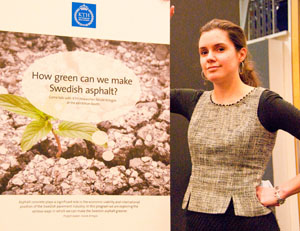Road2Science: Researching Stronger, Safer, Smarter Infrastructure
NEWS
Infrastructure research can be as mundane as finding better ways to make asphalt concrete from crushed rock and oil refinery sludge, and it can be as exotic as designing road surfaces that charge your electric car or notify maintenance crews when cracks are forming. KTH’s new Road2Science research centre will assemble expertise in every facet of designing the highways of the future.

The use of sticky, viscous bitumen as a water-resistant adhesive dates back at least 7000 years, and its modern application in road surfacing is almost as widespread as roads themselves. So what could be left to learn about one of the world’s most common construction materials? Plenty.
“Sustainable transportation means a lot more than just efficient vehicles,” says KTH Associate Professor Niki Kringos. “To make the entire system sustainable, we also have to improve the production processes and performance of our transportation infrastructure.” She adds that the paving material made from a crushed rock mixed with natural or refined bitumen — known variously in the English-speaking world as asphalt, macadam or tarmac — is central to that effort.
Kringos is Scientific Director at KTH’s new Road2Science Centre for Infrastructure Technology, inaugurated in May this year, where a team of researchers is looking at how to cut energy consumption and carbon emissions in road construction, and at how to make highways that incorporate advanced energy capture technologies and support for the next generation of efficient vehicles.
The archaeological record shows that ancient Sumerians of the Middle East used natural asphalt deposits to mortar bricks and stones, and some translations of the Judeo-Christian Bible have the bricks of the Tower of Babel bound with bitumen. The vast majority of asphalt used in our era is of course in road construction, generally as asphalt concrete, a mixture of about 5 per cent bitumen and 95 per cent crushed rock. Because of its viscosity, the asphalt cement has to be heated to properly coat and bind the aggregate.
“Vast amounts of asphalt concrete are used to build highways all over the world, and all that heating is an enormous energy consumer,” Kringos says. “We need to study a transition to cold asphalt production, where the bitumen is emulsified in a soap-and-water solution to reduce viscosity.” Currently used mainly in patching roads, a breakthrough in large-scale cold-mix asphalt production could be a big energy saver, she explains, but it can’t be at the expense of the road’s resistance to wear and weathering. “We need to better understand the chemistry of asphalt and how that affects the mechanical response of the roadway over the long term.”
Even though bitumen is a residue left over from oil refining, it’s not as inexpensive as it once was and infrastructure uses large quantities. “We’re looking at alternatives to petroleum bitumen,” she continues. “And we want to get rid of the hot-mix asphalt plants, with all their pollution and energy consumption.”
Road2Science will also study ways to improve transportation of road-building materials, another area where there are major gains to be made in energy consumption. “Transportation accounts for half of the carbon emissions from road construction. For instance, Swedish granite isn’t the best raw material, so we have to go to Germany or Norway to get high-quality rocks for our roads,” Kringos says. “If we can develop asphalt coatings that work with our local granite, we can cut both costs and environmental impacts.”
Another strategic priority for the centre is looking for ways to reduce cracks and potholes, and even to predict when they will occur. “By making materials more predictable in their behaviour, we can avoid overnight pothole formation and the need for emergency maintenance, as well cutting down on safety hazards like flying stones and hydroplaning. This is where research and practice need to come together,” Kringos says.

The more exotic items on the Road2Science agenda include energy harvesting from infrastructure. With a gigantic network of flat, black surfaces reaching into virtually every community, roads are natural collectors of solar energy that could theoretically be captured, stored and put to use by laying pipes to carry a heat-transfer fluid. The technology is relatively simple and available, but any such scheme will need to be thoroughly studied to ensure that the entombed pipes don’t lead to crack propagation or unpredictable surface behaviour.
A new age of road-building might even help solve the battery-life limitation seen as one of the greatest obstacles to widespread adoption of electric vehicles. Wireless inductive charging is already finding its way into consumer electronics, and in the not-too-distant future electric cars may simply need to be parked over a special conductive pad to generate a magnetic field feeding energy to the batteries. Can roads someday be built to convert solar energy to electricity that powers vehicles as they drive on it? “It won’t happen tomorrow,” Kringos says. “But if it’s going to be a reality for the next generation, we have a lot of research to do today. That’s what Road2Science is all about.”
Kringos describes the new centre as a node in a global infrastructure research network, with partner institutions in Costa Rica, the United States and India, and an active search underway for an affiliate in China. The emphasis is on co-operation between academia and industry aimed at turning innovations into inventions that get put to use in the real world. “Partnering with us will make it easier for a European company to enter the Indian market, or to get access to the brainpower that’s out there,” says Kringos. “It can be very hard to break into a local market when you’re not a local player, and we can help with that.”
Students and researchers joining the new centre will be encouraged to study abroad for up to a year as part of the KTH degree programme, and employees of partner companies will be invited to apply for continuing education opportunities within Road2Science’s international network. “Our people will work closely with industry, which means you’ll see your work being applied,” says Kringos. “On the other hand, you’re also part of the global network, so you get to spend time at facilities in other countries and get exposure to other cultures. If you’re an Indian or Chinese student, you might come to study at KTH and at the same time be part of the network in your home country. Markets are growing closer all the time, and we intend to be part of that.”
By Kevin Billinghurst | kb2@kth.se
